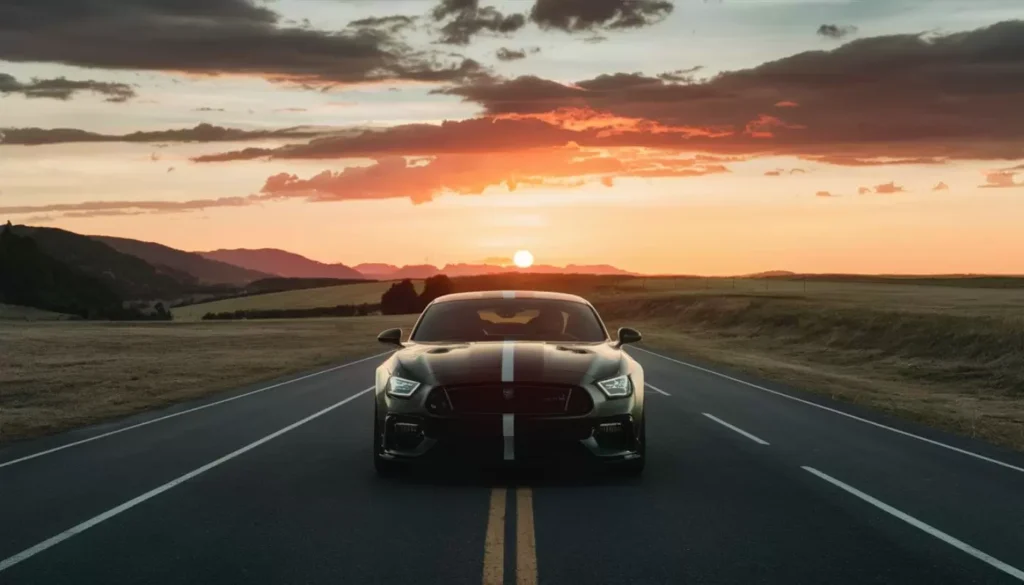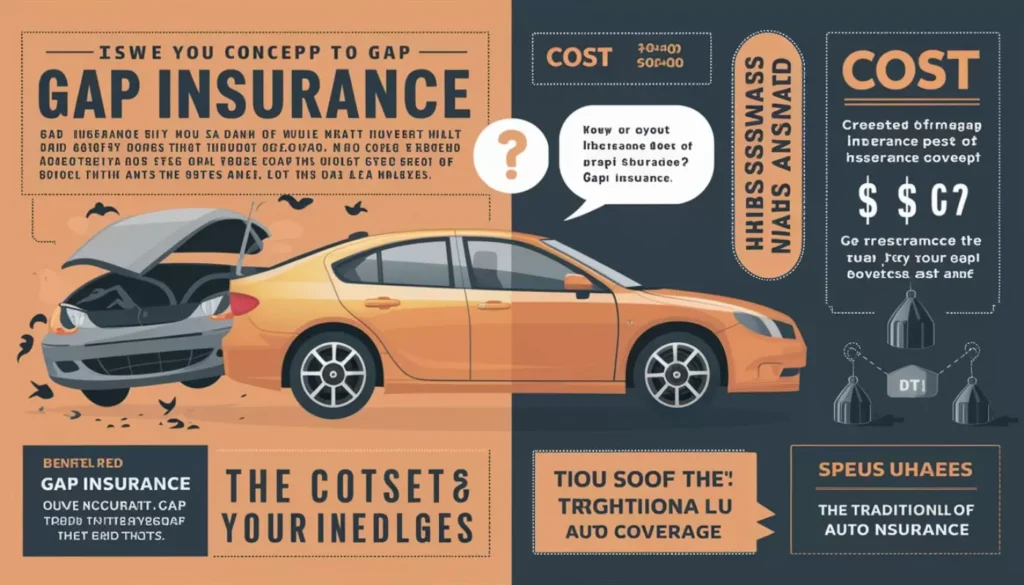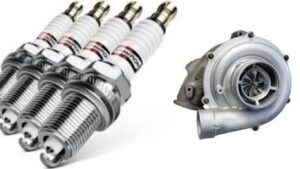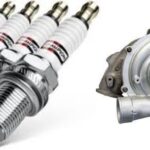In today’s fast-paced world, owning a car is more than just a luxury—it’s often a necessity. But with car ownership comes a web of financial decisions, and one that often leaves drivers scratching their heads is whether to invest in GAP insurance. You’ve probably heard the term thrown around at dealerships or seen it mentioned in loan paperwork, but what exactly is GAP insurance, and more importantly, is it worth your hard-earned money?
Picture this: You’re cruising down the highway in your brand-new car, still reveling in that new car smell, when suddenly—BAM! An accident leaves your prized possession totaled. You breathe a sigh of relief, thinking your insurance will cover it. But here’s the kicker: your insurance check doesn’t even come close to covering what you still owe on your car loan. This is where GAP insurance could be your financial lifesaver.
In this comprehensive guide, we’ll dive deep into the world of GAP insurance. We’ll explore what it is, how it works, who needs it, and ultimately, help you decide if it’s worth adding to your financial protection toolkit. So buckle up, and let’s navigate the twists and turns of GAP insurance together!
What Is GAP Insurance?
GAP insurance, short for Guaranteed Asset Protection insurance, is a type of auto insurance coverage that bridges the gap between what you owe on your car loan and the car’s actual cash value in the event of a total loss. It’s that simple, yet its implications for your financial well-being can be profound.
Let’s break it down with a real-world scenario:
You buy a shiny new car for $30,000. Fast forward a year, and your car’s market value has depreciated to $25,000. You still owe $28,000 on your car loan. Disaster strikes, and your car is totaled in an accident. Your standard auto insurance policy will typically only pay out the current market value of your car—$25,000 in this case. But you still owe the bank $28,000. That $3,000 difference? That’s the “gap” GAP insurance is designed to cover.
It’s crucial to understand that GAP insurance isn’t a standalone policy. It works in tandem with your comprehensive and collision coverage, kicking in when your car is declared a total loss due to an accident, theft, or natural disaster.
Here’s where many drivers get confused: GAP insurance is not the same as standard auto insurance. While your regular policy covers damage, liability, and sometimes medical expenses, GAP insurance focuses solely on that potential financial gap between your car’s value and your loan balance.
How GAP Insurance Works

To truly grasp the value of GAP insurance, let’s walk through how it works step-by-step. Imagine you’ve just driven your new $30,000 car off the lot. Like most new cars, it starts depreciating the moment you take ownership.
- The Accident: Six months later, you’re involved in a serious accident. Your car is declared a total loss.
- Current Value Assessment: Your insurance company determines your car’s actual cash value at the time of the accident is $24,000.
- Standard Insurance Payout: Your comprehensive coverage pays out $24,000 (minus your deductible, let’s say $500).
- Loan Balance Check: You check your loan statement and realize you still owe $28,000 on your car loan.
- The Gap Emerges: There’s now a $4,500 gap between what you owe and what your insurance paid ($28,000 – $23,500).
- GAP Insurance Steps In: This is where your GAP insurance comes to the rescue, covering that $4,500 difference.
Without GAP insurance, you’d be on the hook for that $4,500, still making payments on a car you no longer own. Talk about adding insult to injury!
It’s important to note that GAP insurance does have its limitations. It typically won’t cover:
- Car payments if you lose your job or become disabled
- The cost of a new car
- Carry-over balances from previous car loans
- Late fees or missed payments on your car loan
- Extended warranties added to your car loan
Who Needs GAP Insurance?
Not every driver needs GAP insurance, but for some, it can be a financial lifesaver. Let’s break down who should seriously consider this coverage:
Factors to Consider
- New Car Buyers: If you’ve just purchased a new car, you’re a prime candidate for GAP insurance. New cars depreciate rapidly, often losing 20% of their value in the first year alone.
- Long-Term Auto Loans: Taken out a 60, 72, or even 84-month loan? The longer your loan term, the longer you’re likely to be “upside down” on your loan (owing more than the car is worth).
- Low Down Payment: If you put little or no money down on your car, you’re starting your ownership journey with negative equity.
- Rapidly Depreciating Vehicles: Some cars lose value faster than others. If you’ve bought a model known for quick depreciation, GAP insurance could be crucial.
- Leased Vehicles: Many leases require GAP insurance, and even if they don’t, it’s often a wise choice for lessees.
Who Might Skip GAP Coverage?
On the flip side, GAP insurance might not be necessary if you:
- Bought a used car
- Made a substantial down payment (20% or more)
- Have positive equity in your vehicle
- Paid cash for your car
The Pros of GAP Insurance
- Financial Protection: The most obvious benefit is the protection against potentially owing thousands on a car you can no longer drive.
- Peace of Mind: Knowing you’re covered can alleviate stress in an already stressful situation like a car accident.
- Relatively Low Cost: Compared to the potential out-of-pocket expense of paying off a totaled car, GAP insurance is often quite affordable.
- Potential Savings: In a worst-case scenario, GAP insurance could save you thousands of dollars.
The Cons of GAP Insurance
- Additional Expense: It’s another cost on top of your regular car insurance and loan payments.
- May Never Be Used: Like all insurance, you might pay for it and never need it.
- Limited Coverage Period: GAP insurance is typically only necessary for the first few years of car ownership.
- Possible Overlap: Some auto insurance policies offer similar coverage, so check your existing policy first.
How Much Does GAP Insurance Cost?

The cost of GAP insurance can vary widely depending on where you purchase it and the value of your vehicle. Here’s a general breakdown:
| Provider Type | Average Cost |
| Dealership | $400 – $900 (one-time fee) |
| Insurance Company | $20 – $40 per year |
| Bank/Credit Union | $250 – $600 (one-time fee) |
Factors affecting the cost include:
- The value of your car
- The length of your loan term
- Your location
- The provider you choose
Pro Tip: Shop around! Dealerships often markup GAP insurance significantly. You can often find better rates through your auto insurance provider or a bank.
Alternatives to GAP Insurance
While GAP insurance can be valuable, it’s not the only option for protecting yourself financially:
- New Car Replacement Coverage: Some insurers offer this as an alternative. Instead of paying off your loan, it provides enough money to replace your totaled car with a new one.
- Loan/Lease Payoff Coverage: Similar to GAP insurance but typically only covers a percentage of the difference between your car’s value and your loan balance.
- Self-Insuring: If you have the discipline, you could save the equivalent of GAP insurance premiums in a high-yield savings account. However, this strategy requires time to build up sufficient funds.
Is GAP Insurance Worth It? Making Your Decision
Ultimately, the decision to purchase GAP insurance depends on your individual circumstances. Here’s a quick checklist to help you decide:
- Did you make a down payment of less than 20%?
- Is your loan term longer than 48 months?
- Do you drive more than 15,000 miles per year?
- Did you roll over negative equity from a previous car loan?
- Is your car model known for rapid depreciation?
If you checked most of these boxes, GAP insurance might be a smart move for you.
Case Study: The Value of GAP Insurance
Let’s look at a real-world example:
John bought a new SUV for $35,000 with a 72-month loan and $2,000 down payment. Eighteen months later, his SUV was totaled in an accident. At the time, he owed $30,000 on his loan, but the insurance company valued his car at only $24,000. Without GAP insurance, John would have been on the hook for $6,000. His $500 GAP insurance policy saved him $5,500 in this scenario.
How to Purchase GAP Insurance

If you’ve decided GAP insurance is right for you, here are your options for purchasing:
- Dealerships: Convenient but often the most expensive option.
- Insurance Companies: Can often be added to your existing auto policy at a competitive rate.
- Banks and Credit Unions: May offer GAP insurance when you finance your car through them.
- Online Providers: Some companies specialize in GAP insurance and offer competitive rates.
Remember: Always compare quotes from multiple providers to ensure you’re getting the best deal.
GAP Insurance FAQs
Can I cancel GAP insurance?
Yes, in most cases you can cancel GAP insurance and receive a prorated refund.
Is GAP insurance transferable?
Generally, no. If you sell your car, the GAP insurance doesn’t transfer to the new owner.
Does GAP cover missed payments?
No, GAP insurance typically doesn’t cover any delinquent payments or late fees.
How long does GAP insurance last?
GAP insurance usually lasts for the term of your loan, but you may only need it for the first few years until you have positive equity in your car.
Conclusion.
Bridging the Gap in Your Financial Protection
In the grand scheme of car ownership, GAP insurance is a small but potentially crucial piece of the puzzle. It’s not for everyone, but for many drivers, it provides an extra layer of financial security that can make all the difference in a worst-case scenario.
As you weigh the pros and cons, remember that the goal is to protect your financial well-being. Consider your car’s depreciation rate, your loan terms, and your personal risk tolerance. If the potential gap between your car’s value and your loan balance keeps you up at night, GAP insurance might help you sleep a little easier.
Ultimately, the decision is yours. Armed with the knowledge from this guide, you’re now equipped to make an informed choice about whether GAP insurance is worth it for your unique situation. Whatever you decide, drive safely, and may your journeys be filled with more joy than gaps!

Marathi author Anju Mary has made a mark in the literary world with her innovative storytelling and deep passion for reading. Her unique narrative style and creative approach offer readers a distinctive and enriching experience, solidifying her reputation as a prominent writer.











